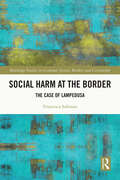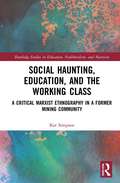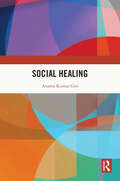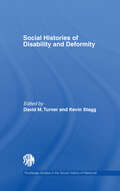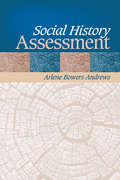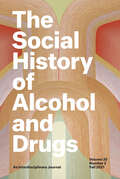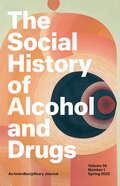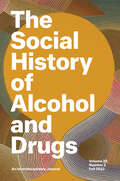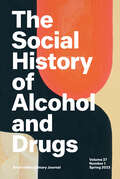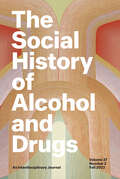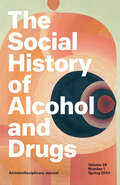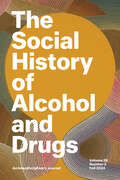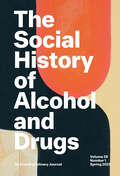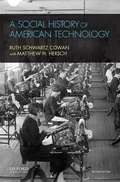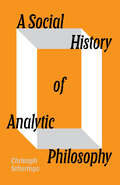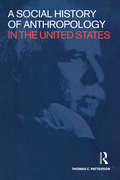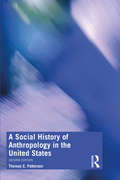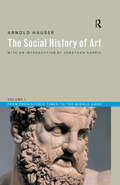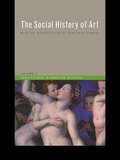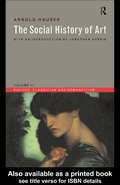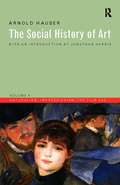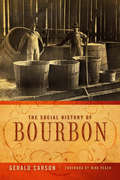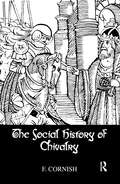- Table View
- List View
Social Harm at the Border: The Case of Lampedusa (Routledge Studies in Criminal Justice, Borders and Citizenship)
by Francesca SolimanThis book offers a zemiological approach for understanding border control practices, state power, and their social impact. Drawing on an ethnographic study on the borderisation of the Mediterranean island of Lampedusa, it explores border harms from the perspective of the non-migrant community. Social Harm at the Border examines a range of social harms associated with border control, and draws on themes of security, racialised humanitarianism, economic harms, environment, and culture. It explores the ways in which borderisation exercises control over both migrants and non-migrants, ensuring that border communities remain subordinated to the power of institutional actors, and it offers a novel framework with which to illuminate and explain border harms and their generative mechanisms. An accessible and compelling read, this book will appeal to students and scholars of criminology, zemiology, sociology, criminal justice, politics, geography, and those interested in the harms caused by border control practices.
Social Haunting, Education, and the Working Class: A Critical Marxist Ethnography in a Former Mining Community (Routledge Studies in Education, Neoliberalism, and Marxism)
by Kat SimpsonBased on a critical Marxist ethnography, conducted at a state primary school in a former coalmining community in the north of England, this book provides insight into teachers’ perceptions of the effects of deindustrialisation on education for the working class. The book draws on the notion of social haunting to help understand the complex ways in which historical relations and performances, reflective of the community’s industrial past, continue to shape experiences and processes of schooling. The arguments presented enable us to engage with the ‘goodness’ of the past as well as the pain and suffering associated with deindustrialisation. This, it is argued, enables teachers and pupils to engage with rhythms, relations, and performances that recognise the heritage and complexities of working-class culture. Reckoning and harnessing with the fullness of ghosts is essential if schooling is to be refashioned in more encouraging and relational ways, with and for the working class. This text will benefit researchers, academics, and educators with an interest in the sociology of education, and social class and education in particular. Those interested in schooling, ethnography, and qualitative social research will also benefit from the book
Social Healing
by Ananta Kumar GiriSocial Healing draws on a transdisciplinary approach— bringing sociology, philosophy, psychology, and spirituality together — to understand health, social suffering, and healing in our contemporary world. It shows how we can transform the present discourse and reality of social suffering by multi-dimensional movements of social healing. The author argues for the need for a new art of healing in place of the dominant and pervasive technology and politics of killing. It discusses manifold creative theories and practices of healing in self, society, and the world as well as new movements in social theory, philosophy, and social sciences which deploy creative methods of art and performance in healing our psychic and social wounds. It explores the spiritual, social, ethical, and political dimensions of health and healing. This pioneering work will be of great interest to scholars and researchers of social theory, sociology, politics, philosophy, and psychology.
Social Histories of Disability and Deformity: Bodies, Images and Experiences (Routledge Studies in the Social History of Medicine #Vol. 25)
by Kevin Stagg David M. TurnerCollecting together essays written by an international set of contributors, this book provides an important contribution to the emerging field of disability history. It explores changes in understandings of deformity and disability between the sixteenth and twentieth centuries, and reveal the ways in which different societies have conceptualised the normal and the pathological. Through a variety of case studies including: early modern birth defects, homosexuality, smallpox scarring, vaccination, orthopaedics, deaf education, eugenics, mental deficiency, and the experiences of psychologically scarred military veterans, this book provides new perspectives on the history of physical, sensory and intellectual anomaly. Examining changes over five centuries, it charts how disability was delineated from other forms of deformity and disfigurement by a clearer medical perspective. Essays shed light on the experiences of oppressed minorities often hidden from mainstream history, but also demonstrate the importance of discourses of disability and deformity as key cultural signifiers which disclose broader systems of power and authority, citizenship and exclusion. The diverse nature of the material in this book will make it relevant to scholars interested in cultural, literary, social and political, as well as medical, history.
Social History Assessment
by Arlene B. Andrews"Her book takes us on a journey back to the basics of conducting a thorough and informative social history and is an account of what a real social history involves...I recommend this book not only for the novice but also for all clinicians who want an edge on how to accumulate more pertinent information concerning their patients and to guide their treatment." —PSYCCRITIQUES "...what impresses me about this text is that Andrews uses her love of social history to take a subject that is rarely celebrated and remind us of what is exciting about it." —FAMILIES IN SOCIETY In the mental health and human service professions, taking a social history assessment marks the start of most therapeutic interventions. Social History Assessment is the first resource to offer practical guidance about interpreting the social history. Author Arlene Bowers Andrews provides rich resources to assist helping professionals as they gather and–most importantly–interpret information about social relationships in the lives of individuals. Key Features: Focuses on interpreting and making meaning of the social history: Humans are complex creatures. Their biology, psychology, and social relations affect their thoughts, emotions, behaviors, and sensations. This book particularly addresses the personal social history, that is, the interpersonal relationships that have influenced the development of the person during the life course. Offers comprehensive guidance on composing a social history: In addition to numerous case examples and a variety of helpful tools such as genograms and ecomaps, the chapters cover ethical issues, core theories of human behavior in the social environment, tips for comprehensively gathering information about and describing the social history, and guidance regarding interpreting the history. Reaches a multidisciplinary audience: Whether the professional comes from social work, psychology, counseling, psychiatry, nursing, or another health or human service discipline, exploring the client’s origins helps build rapport and lays the foundation for mutual client-professional assessment. This book offers a common understanding across disciplines of what constitutes an informative social history, with theoretically grounded interpretation, to benefit multidisciplinary teamwork and the client. Intended Audience: This is an ideal supplemental text for a variety of advanced undergraduate and graduate courses in Social Work Practice, Direct Practice, Interviewing, Human Behavior in the Social Environment, Family Studies, Education (counseling), Psychology (counseling and clinical), and Nursing. It is also an excellent resource for Social Workers, Counselors, and Psychologists.
A Social History of Administrative Science in Italy: Planning a State of Happiness from Liberalism to Fascism (Italian and Italian American Studies)
by Andrea RapiniThis book traces the origins, life and death of Administrative Science in Italy as an academic discipline between the nineteenth and twentieth centuries. It does so by combining the study of ideas, institutional history, intellectual history and social history. The Faculty of Law first introduced Administrative Science in 1875, with the aim of providing the elite with the necessary tools to distribute wealth more equally, to take care of the population and, thus, to make the young Italian State more legitimate in the eyes of the emerging masses. Law and social sciences were merged with the aim of increasing reforms, including that of creating a State of Happiness for all citizens. Throughout its 70-year existence, Administrative Science was deprived of its contents and scientific independence, and academically overshadowed by Administrative and Public law. Finally, although the liberal elites discarded the reformer project of Administrative Science even before Fascism turned everything upside down, most of the original traits of this knowledge were absorbed into Fascist corporate and totalitarian structures.
The Social History of Alcohol and Drugs, volume 35 number 2 (Fall 2021)
by The Social History of Alcohol and DrugsThis is volume 35 issue 2 of The Social History of Alcohol and Drugs. The Social History of Alcohol and Drugs: An Interdisciplinary Journal (SHAD) is a peer-reviewed academic journal dedicated to publishing high-quality original academic research, reflection essays, and reviews in the field of alcohol and drug history, broadly construed. SHAD appears twice annually as an official publication of the Alcohol and Drugs History Society, which promotes scholarship and discussions about the history of alcohol and drug use, abuse, production, trade, and regulation across time and space.
The Social History of Alcohol and Drugs, volume 36 number 1 (Spring 2022)
by The Social History of Alcohol and DrugsThis is volume 36 issue 1 of The Social History of Alcohol and Drugs. The Social History of Alcohol and Drugs: An Interdisciplinary Journal (SHAD) is a peer-reviewed academic journal dedicated to publishing high-quality original academic research, reflection essays, and reviews in the field of alcohol and drug history, broadly construed. SHAD appears twice annually as an official publication of the Alcohol and Drugs History Society, which promotes scholarship and discussions about the history of alcohol and drug use, abuse, production, trade, and regulation across time and space.
The Social History of Alcohol and Drugs, volume 36 number 2 (Fall 2022)
by The Social History of Alcohol and DrugsThis is volume 36 issue 2 of The Social History of Alcohol and Drugs. The Social History of Alcohol and Drugs: An Interdisciplinary Journal (SHAD) is a peer-reviewed academic journal dedicated to publishing high-quality original academic research, reflection essays, and reviews in the field of alcohol and drug history, broadly construed. SHAD appears twice annually as an official publication of the Alcohol and Drugs History Society, which promotes scholarship and discussions about the history of alcohol and drug use, abuse, production, trade, and regulation across time and space.
The Social History of Alcohol and Drugs, volume 37 number 1 (Spring 2023)
by The Social History of Alcohol and DrugsThis is volume 37 issue 1 of The Social History of Alcohol and Drugs. The Social History of Alcohol and Drugs: An Interdisciplinary Journal (SHAD) is a peer-reviewed academic journal dedicated to publishing high-quality original academic research, reflection essays, and reviews in the field of alcohol and drug history, broadly construed. SHAD appears twice annually as an official publication of the Alcohol and Drugs History Society, which promotes scholarship and discussions about the history of alcohol and drug use, abuse, production, trade, and regulation across time and space.
The Social History of Alcohol and Drugs, volume 37 number 2 (Fall 2023)
by The Social History of Alcohol and DrugsThis is volume 37 issue 2 of The Social History of Alcohol and Drugs. The Social History of Alcohol and Drugs: An Interdisciplinary Journal (SHAD) is a peer-reviewed academic journal dedicated to publishing high-quality original academic research, reflection essays, and reviews in the field of alcohol and drug history, broadly construed. SHAD appears twice annually as an official publication of the Alcohol and Drugs History Society, which promotes scholarship and discussions about the history of alcohol and drug use, abuse, production, trade, and regulation across time and space.
The Social History of Alcohol and Drugs, volume 38 number 1 (Spring 2024)
by The Social History of Alcohol and DrugsThis is volume 38 issue 1 of The Social History of Alcohol and Drugs. The Social History of Alcohol and Drugs: An Interdisciplinary Journal (SHAD) is a peer-reviewed academic journal dedicated to publishing high-quality original academic research, reflection essays, and reviews in the field of alcohol and drug history, broadly construed. SHAD appears twice annually as an official publication of the Alcohol and Drugs History Society, which promotes scholarship and discussions about the history of alcohol and drug use, abuse, production, trade, and regulation across time and space.
The Social History of Alcohol and Drugs, volume 38 number 2 (Fall 2024)
by The Social History of Alcohol and DrugsThis is volume 38 issue 2 of The Social History of Alcohol and Drugs. The Social History of Alcohol and Drugs: An Interdisciplinary Journal (SHAD) is a peer-reviewed academic journal dedicated to publishing high-quality original academic research, reflection essays, and reviews in the field of alcohol and drug history, broadly construed. SHAD appears twice annually as an official publication of the Alcohol and Drugs History Society, which promotes scholarship and discussions about the history of alcohol and drug use, abuse, production, trade, and regulation across time and space.
The Social History of Alcohol and Drugs, volume 39 number 1 (Spring 2025)
by The Social History of Alcohol and DrugsThis is volume 39 issue 1 of The Social History of Alcohol and Drugs. The Social History of Alcohol and Drugs: An Interdisciplinary Journal (SHAD) is a peer-reviewed academic journal dedicated to publishing high-quality original academic research, reflection essays, and reviews in the field of alcohol and drug history, broadly construed. SHAD appears twice annually as an official publication of the Alcohol and Drugs History Society, which promotes scholarship and discussions about the history of alcohol and drug use, abuse, production, trade, and regulation across time and space.
A Social History of American Technology
by Ruth Schwartz Cowan(back of book) For over 250 years American technology has been regarded as a unique hallmark of American culture and an important factor in American prosperity. Despite this, American history has rarely been told from the perspective of the history of technology. A Social History of American Technology fills this gap by surveying the history of American technology from the tools used by the earliest native inhabitants to the technological systems- cars and computers, aircraft and antibiotics- we are familiar with today. Cowan makes use of the most recent scholarship to explain how the unique characteristics of American cultures and American geography have affected the technologies that have been invented, manufactured, and used throughout the years. She also focuses on the key individuals and ideas that have shaped important technological developments. The text explains how various technologies have affected the ways in which Americans work, govern, cook, transport, communicate, maintain their health, and reproduce. Cowan demonstrates that technological change has always been closely related to social development, and explores the multiple, complex relationships that have existed between such diverse social agents as households and businesses, the scientific community and the defense establishment, artists and inventors. Divided into three sections- colonial America. industrialization, the 20th century- A Social History of American Technology is ideal for courses in American social and economic history, as a correlated text for the American history survey, as well as for courses that focus on the history of technology. It offers students the unique opportunity to learn not only how profoundly technological change has affected the American way of life, but how profoundly the American way of life has affected technology.
A Social History of American Technology (Second Edition)
by Ruth Schwartz Cowan Matthew H. HerschA Social History of American Technology, Second Edition, tells the story of American technology from the tools used by its earliest inhabitants to the technological systems - cars and computers, aircraft and antibiotics - that we are familiar with today. Ruth Schwartz Cowan and Matthew H. Hersch demonstrate how technological change has always been closely related to social and economic development, and examine the important mutual relationships between social history and technological change. They explain how the unique characteristics of American cultures and American geography haveaffected the technologies that have been invented, manufactured, and used throughout the years - and also the reverse: how those technologies have affected the daily lives, the unique cultures, and the environments of all Americans.
A Social History of Analytic Philosophy
by Christoph SchuringaHow a supposedly apolitical form of philosophy owes its continuing power to social and political forcesAnalytic philosophy is the leading form of philosophy in the English-speaking world. What explains its continued success? Christoph Schuringa argues that its enduring power can only be understood by examining its social history. Analytic philosophy tends to think of itself as concerned with eternal questions, transcending the changing scenes of history. It thinks of itself as apolitical. This book, however, convincingly shows that the opposite is true.The origins of analytic philosophy are in a set of distinct movements, shaped by high-ly specific sets of political and social forces. Only after the Second World War were these disparate, often dynamic movements joined together to make &‘analytic philosophy&’ as we know it. In the climate of McCarthyism, analytic philosophy was robbed of political force.To this day, analytic philosophy is the ideology of the status quo. It may seem arcane and largely removed from the real world, but it is a crucial component in upholding liberalism, through its central role in elite educational institutions. As Schuringa concludes, the apparently increasing friendliness of analytic philosophers to rival approaches in philosophy should be understood as a form of colonization; thanks to its hegemonic status, it reformats all it touches in service of its own imperatives, going so far as to colonize decolonial efforts in the discipline.
A Social History of Anthropology in the United States: Second Edition
by Thomas C. PattersonIn part due to the recent Yanomami controversy, which has rocked anthropology to its very core, there is renewed interest in the discipline's history and intellectual roots, especially amongst anthropologists themselves. The cutting edge of anthropological research today is a product of earlier questions and answers, previous ambitions, preoccupations and adventures, stretching back one hundred years or more. This book is the first comprehensive history of American anthropology. Crucially, Patterson relates the development of anthropology in the United States to wider historical currents in society. American anthropologists over the years have worked through shifting social and economic conditions, changes in institutional organization, developing class structures, world politics, and conflicts both at home and abroad. How has anthropology been linked to colonial, commercial and territorial expansion in the States? How have the changing forms of race, power, ethnic identity and politics shaped the questions anthropologists ask, both past and present? Anthropology as a discipline has always developed in a close relationship with other social sciences, but this relationship has rarely been scrutinized. This book details and explains the complex interplay of forces and conditions that have made anthropology in America what it is today. Furthermore, it explores how anthropologists themselves have contributed and propagated powerful images and ideas about the different cultures and societies that make up our world. This book will be essential reading for anyone interested in understanding the roots and reasons behind American anthropology at the turn of the twenty-first century. Intellectual historians, social scientists, and anyone intrigued by the growth and development of institutional politics and practices should read this book.
A Social History of Anthropology in the United States
by Thomas C. PattersonThis book offers a comprehensive introduction to the social history of anthropology in the United States, examining the circumstances that gave rise to the discipline and illuminating the role of anthropology in the modern world. Thomas C. Patterson considers the shifting social and political-economic conditions in which anthropological knowledge has been produced and deployed, the appearance of practices focused on particular regions or groups, the place of anthropology in structures of power, and the role of the educator in forging, perpetuating, and changing representations of past and contemporary peoples. The book addresses the negative reputation that anthropology took on as an offspring of imperialism, and provides fascinating insight into the social history of America. In this second edition, the material has been revised and updated, including a new chapter that covers anthropological theory and practice during the turmoil created by multiple ongoing crises at the beginning of the twenty-first century. This is valuable reading for students and scholars interested in the origins, development, and theory of anthropology.
Social History of Art, Volume 1: From Prehistoric Times to the Middle Ages
by Arnold HauserFirst published in 1951 Arnold Hausers commanding work presents an account of the development and meaning of art from its origins in the Stone Age through to the Film Age. Exploring the interaction between art and society, Hauser effectively details social and historical movements and sketches the frameworks in which visual art is produced.This new edition provides an excellent introduction to the work of Arnold Hauser. In his general introduction to The Social History of Art, Jonathan Harris asseses the importance of the work for contemporary art history and visual culture. In addition, an introduction to each volume provides a synopsis of Hausers narrative and serves as a critical guide to the text, identifying major themes, trends and arguments.
Social History of Art, Volume 2: Renaissance, Mannerism, Baroque
by Arnold HauserFirst published in 1951 Arnold Hauser's commanding work presents an account of the development and meaning of art from its origins in the Stone Age through to the Film Age. Exploring the interaction between art and society, Hauser effectively details social and historical movements and sketches the frameworks in which visual art is produced.This new edition provides an excellent introduction to the work of Arnold Hauser. In his general introduction to The Social History of Art, Jonathan Harris asseses the importance of the work for contemporary art history and visual culture. In addition, an introduction to each volume provides a synopsis of Hauser's narrative and serves as a critical guide to the text, identifying major themes, trends and arguments.
Social History of Art, Volume 3: Rococo, Classicism and Romanticism
by Arnold HauserFirst published in 1951 Arnold Hausers commanding work presents an account of the development and meaning of art from its origins in the Stone Age through to the Film Age. Exploring the interaction between art and society, Hauser effectively details social and historical movements and sketches the frameworks in which visual art is produced.This new edition provides an excellent introduction to the work of Arnold Hauser. In his general introduction to The Social History of Art, Jonathan Harris asseses the importance of the work for contemporary art history and visual culture. In addition, an introduction to each volume provides a synopsis of Hausers narrative and serves as a critical guide to the text, identifying major themes, trends and arguments.
Social History of Art, Volume 4: Naturalism, Impressionism, The Film Age
by Arnold HauserFirst published in 1951 Arnold Hausers commanding work presents an account of the development and meaning of art from its origins in the Stone Age through to the Film Age. Exploring the interaction between art and society, Hauser effectively details social and historical movements and sketches the frameworks in which visual art is produced.This new edition provides an excellent introduction to the work of Arnold Hauser. In his general introduction to The Social History of Art, Jonathan Harris asseses the importance of the work for contemporary art history and visual culture. In addition, an introduction to each volume provides a synopsis of Hausers narrative and serves as a critical guide to the text, identifying major themes, trends and arguments.
The Social History of Bourbon: An Unhurried Account Of Our Star-spangled American Drink
by Gerald CarsonA high-spirited history of the role bourbon has played in American life and culture, &“documented and full of folklore&” (Kirkus Reviews). The distinctive beverage of the Western world, bourbon is Kentucky&’s illustrious gift to the nation. While much has been written about whiskey, the particular place of bourbon in the American cultural record has long awaited detailed and objective presentation. A fascinating and informative contribution to Americana, The Social History of Bourbon reflects an aspect of our national cultural identity that has been widely overlooked. Gerald Carson explores the impact of the liquor&’s presence during America&’s early development, as well as bourbon&’s role in some of the more dramatic events in American history, including the Whiskey Rebellion, the scandals of the Whiskey Ring, and the &“whiskey forts&” of the fur trade. From moonshiners to the Civil War to Old West saloons and the privations of Prohibition, The Social History of Bourbon is a revealing look at the role of this classic beverage in the development of American manners and culture. &“Goes into the families and personalities of bourbon&’s early history and does so with humor . . . a great cause to raise a glass.&” ―Rowley&’s Whiskey Forge
Social History Of Chivalry
by F_CORNISHFirst published in 2005. Routledge is an imprint of Taylor & Francis, an informa company.
